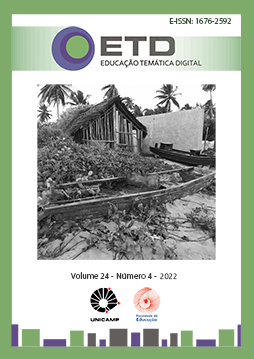Abstract
The blue epistemologies of indigenous sign languages emerging in intercultural contexts seek to reflect on the theoretical assumptions of deaf studies in indigenous contexts. These are epistemological reflections carried out by researchers João Carlos Gomes, from the Federal University of Rondônia (UNIR) and Shirley Vilhalva from the Federal University of Mato Grosso do Sul (UFMS). The study will seek to reflect on the emerging signs used by deaf indigenous people in the processes of communication and expression in indigenous contexts. The study will have as an epistemological basis the post-critical assumptions of theoretical studies of emerging sign languages. Based on these theoretical assumptions, the researchers analyzed the communication and expression strategies used through natural signs that make emerging signs in indigenous sign language based on the culture and identity of indigenous deaf people. The study will demonstrate that family signs have intercultural iconographic configurations that can be used as their own teaching-learning processes in the context of indigenous schools. In this perspective, researchers recognize that most emerging languages have a duration that are "established" according to the need for communication and expression processes in indigenous territories. These are languages that are institutionalized by small groups of deaf indigenous people who use their cultural roots to produce emergent signs. These are languages that go through a process of evolution faster than institutionalized sign languages. These emerging languages are difficult to map and may not be uniform in their linguistic structures, considering lexicon, morphology, syntax and pragmatics.
References
ALBRES, Neiva de Aquino. A educação de alunos surdos no Brasil do final da década de 70 a 2005: análise dos documentos referenciadores. Campo Grande: UFMS, 2005, p. 4.
ALVES, Rubem. Variações sobre o prazer: Santo Agostinho-Nietzsche-Marx e Bebette. São Paulo: Planeta, 2011.
BRASIL, Resolução nº 5, de 22 de junho de 2012, define Diretrizes Curriculares Nacionais para a Educação Escolar Indígena na Educação Básica. Ministério da Educação, Conselho Nacional de Educação, Câmara de Educação Básica, Brasília, DF, 2012.
FREIRE, P. A importância do ato de ler. 23. ed. São Paulo: Autores Associados: Cortez, 1989. p. 11.
GOMES. João Carlos. VILHALVA, Shirley. As línguas de sinais indígenas em contextos interculturais. Curitiba: CVR, 2021.
NONAKA, Angela M. The forgotten endangered languages: lessons on the importance of remembering from Thailand's Ban Khor Sign Language. Language in Society, v.33, n. 5 p.737-767, 2004.
QUADROS, Ronice M. KARNOPP, Lodenir B. Língua de sinais brasileira: estudos linguísticos. Porto Alegre: ArtMed, 2004.
RIBEIRO, Branca Telles; GARCEZ, Pedro M. (Org.). Sociolinguística interacional. São Paulo: Edições Loyola, 2002.
VILHALVA, Shirley. Índios surdos: mapeamento das línguas de sinais do Mato Grosso do Sul. Petrópolis, RJ: Arara Azul, 2012.

This work is licensed under a Creative Commons Attribution-NonCommercial-NoDerivatives 4.0 International License.
Copyright (c) 2022 ETD - Educação Temática Digital


